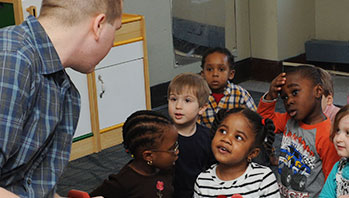- chart paper
- Discovery Time materials from the week
- marker
- Music Mural paintings
- sound
- tube
- vibrate
MA Standards:
Speaking and Listening:SL.PK.MA.1 Participate in collaborative conversations with diverse partners during daily routines and play.
Language:L.PK.MA.1 Demonstrate use of oral language in informal everyday activities.
Head Start Outcomes:
Language Development/Receptive Language Attends to language during conversations, songs, stories, or other learning experiences.
Language Development/Expressive Language Uses language to express ideas and needs.
Social Emotional Development/Self-Concept and Self-Efficacy Identifies personal characteristics, preferences, thoughts, and feelings.
PreK Learning Guidelines:
English Language Arts/Language 2 Participate actively in discussions, listen to the ideas of others, and ask and answer relevant questions.
English Language Arts/Language 3 Communicate personal experiences or interests.
Science and Technology/Inquiry Skills 4 Record observations and share ideas through simple forms of representation such as drawings.
Talk Together: Sound and Music

© Commonwealth of Massachusetts, Department of Early Education and Care (Jennifer Waddell photographer). All rights reserved.
STEM Key Concepts: Sounds vary in three ways: volume (loud or soft), pitch (high or low), and timbre (quality); Sounds sound different when they travel through a hollow object; A sound becomes louder when the force of the action that is creating the sound is increased (for example, when you hit a drum harder); A sound becomes softer, or quieter, when the force is decreased; Different objects make different sounds
ELA Focus Skills: Listening and Speaking, Vocabulary
Display the rubber band guitars and tubes from the Discovery Time activities during the week. Review with children what they observed during their explorations. Invite children to demonstrate what they learned this week. Say, for example, What do you remember about the sounds you made on the rubber band guitar, Sam? Can you make some of the sounds?
- Encourage children to use any new sound vocabulary they learned this week to talk about their observations.
- Ask questions about children’s observations to help engage children further, such as, When you watched the rubber band vibrate, what did you notice happened to the sound? Why do you think that happened?
